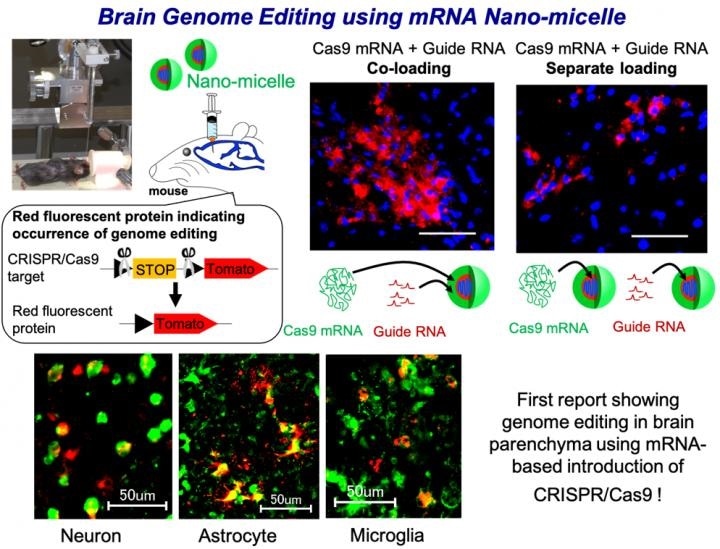A research team of Dr. Satoshi Uchida, Deputy Principal Research Scientist and Associate Professor from the Kyoto Prefectural University of Medicine at the Innovation Center of NanoMedicine (iCONM), and Kazunori Kataoka, Professor and Director General from iCONM Kawasaki, Japan, has reported that improved nano-micelles can trigger efficient genome editing in the mouse brain.

First report showing genome editing in brain parenchyma using mRNA-based introduction of CRISPR/Cas9. Image Credit: 2021 Innovation Center of NanoMedicine.
The CRISPR/Cas9 technology, which won the 2020 Chemistry Nobel Prize, shows excellent potential for treating a range of diseases, like viral infections and congenital disorders, by fixing disease-specific genomic sequences.
In the last 10 years, the CRISPR/Cas9 technology has attracted increasing attention since it enables researchers to easily target genomic sequences with excellent accuracy and with reduced level of unnecessary off-target gene editing.
But the efficient and safe transport of the Cas9 DNA cutting enzyme as well as guide RNA (gRNA)—a short segment of RNA that directs Cas9 to its genomic targets—continues to pose a major barrier.
To resolve this problem, the researchers created nano-micelle to deliver Cas9-encoding messenger RNA (mRNA) and gRNA, which condenses these mRNAs in the core of the micelle and creates a protective shell of polyethylene glycol.
The team assessed the performance of genome editing in transgenic mice that express a red fluorescent protein upon effective genome editing in the mouse brain. Both gRNA (100 base) and Cas9 mRNA (4500 base) are highly different in size, and when each of these RNAs was loaded independently in a nano-micelle, the gRNA was quickly released and degraded.
Fascinatingly, when both gRNA and Cas9 mRNA were loaded in the same nano-micelle, the stability of the former increased and the co-loaded nano-micelle enabled more efficient genome editing in different brain cells, like astrocytes, microglia, and neurons.
This is the first-ever study to verify the utility of RNA-based CRISPR/Cas9 in brain parenchyma. Moreover, it was observed that the polyethylene glycol present on the surface of nano-micelle plays a crucial role in the diffusion of brain tissues following injection, making it possible to induce higher genome editing.
The nano-micelle denotes a safe and effective method that could be used for treating genetic brain disorders, like Huntington’s disease, and other neurodegenerative diseases, like Alzheimer’s.
Source:
Journal reference:
Abbasi, S., et al. (2021) Co-encapsulation of Cas9 mRNA and guide RNA in polyplex micelles enables genome editing in mouse brain. Journal of Controlled Release. doi.org/10.1016/j.jconrel.2021.02.026.